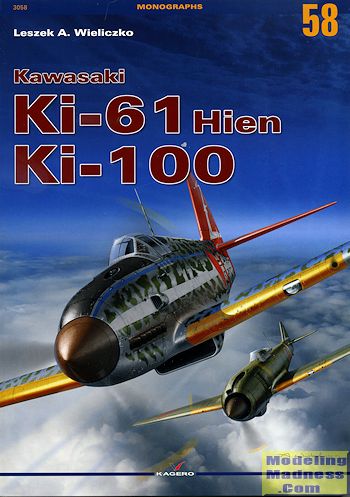Kagero's Kawasaki Ki-61 Hien & Ki-100
 Throughout
WWII, the Japanese aviation industry relied pretty much on air-cooled radial
engines to power everything from fighters to bombers to transports and liaison
aircraft. They were good at it and while the power produced was rarely world
class, they were reliable and fit in with the light aircraft that Japan was used
to producing. However, the war in Europe saw the skies filled with fighters that
used liquid cooled engines. These were able to produce more power than
contemporary radials and offered the benefit of improved streamlining.
Throughout
WWII, the Japanese aviation industry relied pretty much on air-cooled radial
engines to power everything from fighters to bombers to transports and liaison
aircraft. They were good at it and while the power produced was rarely world
class, they were reliable and fit in with the light aircraft that Japan was used
to producing. However, the war in Europe saw the skies filled with fighters that
used liquid cooled engines. These were able to produce more power than
contemporary radials and offered the benefit of improved streamlining.
So it was that the Japanese went to
Germany and imported several Bf-109E fighters, several DB.601 engines and a
license to build the engines. It was decided that what was needed were a pair of
fighters powered by this engine. One would be a 'heavy' fighter with more
powerful armament and the other typical of planes currently in service, a
'light' fighter with basically rifle calibre guns. Kawasaki's main designer felt
that something in between was what was really needed. But he didn't pay the
bills and so Kawasaki started work on the heavy fighter first.
This plane was to become the Ki-60 and
three prototypes were built, all of them using German made DB.601s. The building
of the engine in Japan, soon to be called the Ha-40 was not going all that well.
Japan did not have the experience in metallurgy that the Germans had so had to
adapt what they had and it was a tough slog. Such was the situation that even
when the engine became reliable to enter full production, it was a slow build.
Even then, the engine was found to be quite complicated compared to what they
were used to doing and in the field, engine maintenance became a major issue.
Back at the Ki-60. The prototypes were
completed, but it was found that their performance did not meet what was hoped
for. The aircraft were overweight and so performance suffered. Still, they were
put through their paces and much was learned, even though the program was
eventually cancelled with no preproduction order.
Instead, the Ki-61 was started and was
not the light fighter that was originally envisioned, but a medium fighter that
incorporated speed, maneuverability and a reasonable armament that would help
the Ki-61 hold its own in combat. Several variants were developed, but
throughout its life, engines were always an issue. Part of this was due to slow
production, lack of quality control and a nearly non-existent supply line that
often left planes grounded for even small items. The death blow to the type came
with the bombing of the engine factory, which left dozens of completed airframes
without power plants.
A crash development program was started
to adapt a bomber engine to the Ki-61 airframe and this resulted in the very
successful Ki-100. Naturally, it was too little too late and while the Ki-100
was a fine airplane, it was not superior to what the Allies were fielding,
though it was quite close.
This book covers the events that led up
to the development of the Ki-60 as well as the full development story of this
plane and the later Ki-61 and Ki-100. All of the different variants are covered
and this includes some excellent scale drawings, including a pair of huge
supplementary sheets in 1/32 scale. Full information on the operational career
is also provided and we get several pages of stats, information on camouflage
and markings schemes as well as several pages of large, full color profiles.
In all, it is a superb volume and one
that anyone with an interest in this plane should have on their shelves.
March 2015
My thanks to Casemate Publishing for the review sample. Visit them at
Casemate Publishing and order yours, or get them at
your favorite hobbyist.
If you would like your product reviewed fairly and
fairly quickly, please contact
me or see other details in the Note to
Contributors.
 Throughout
WWII, the Japanese aviation industry relied pretty much on air-cooled radial
engines to power everything from fighters to bombers to transports and liaison
aircraft. They were good at it and while the power produced was rarely world
class, they were reliable and fit in with the light aircraft that Japan was used
to producing. However, the war in Europe saw the skies filled with fighters that
used liquid cooled engines. These were able to produce more power than
contemporary radials and offered the benefit of improved streamlining.
Throughout
WWII, the Japanese aviation industry relied pretty much on air-cooled radial
engines to power everything from fighters to bombers to transports and liaison
aircraft. They were good at it and while the power produced was rarely world
class, they were reliable and fit in with the light aircraft that Japan was used
to producing. However, the war in Europe saw the skies filled with fighters that
used liquid cooled engines. These were able to produce more power than
contemporary radials and offered the benefit of improved streamlining.